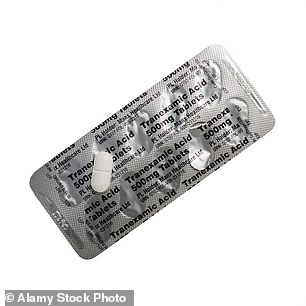DR. JEN GUNTER: A 10-cent pill can relieve the painful menstrual cramps of millions of women… so why don’t doctors and pharmacists tell their patients about it?




Around nine million British women suffer from severe and persistent pain for around five days a month, preventing some from working, caring for children or even moving.
I’m talking about period pain, or menstrual cramps, which according to the most recent surveys are severe in two-thirds of people with monthly bleeding.
As a gynecologist, my job is to provide patients with treatments that improve their condition and ultimately improve their quality of life.
But when it comes to menstrual pain, GPs and other healthcare professionals do not seem to take the same approach.
Most women have never heard that there is a pill that can cut the amount of blood loss in half, which significantly reduces pain.

Research shows that two-thirds of British women who menstruate describe their pain as severe
It is called tranexamic acid and is a tablet that you take three times a day for up to four days. It is available both on prescription and over the counter.
It’s much cheaper on prescription, with GPs offering up to 60 tablets for £9.90, compared to a pack of 18 tablets costing £15 from Boots.
It’s also a steal for the NHS: a tablet costs the health service less than ten pence.
But so few women know about it because medical professionals rarely talk about it, I hear from patients.
And that’s exactly why I decided to write about it last week as part of my weekly newsletter, The Vajenda.
A 2023 report from the charity Wellbeing of Women found that half of women who experience severe period pain feel that healthcare providers do not take it seriously.
This largely stems from the widespread perception that menstruation is ‘no big deal’ and that women are ‘used to’ dealing with it.
Dr Philippa Kaye, GP and This Morning regular, agrees. ‘For far too long there has been a perception in society that women have to endure pain,’ she says.
‘It’s not just that health care providers don’t inform patients about the options available, but many women and girls don’t seek help in the first place.
“They think it’s normal to be afraid of being far from a toilet during their period.”
But you don’t have to accept it.
Heavy, painful periods are not only annoying, they can also have serious consequences.
This is because heavy blood loss can lead to anemia, or iron deficiency.

Dr. Jen Gunter is often described as the internet’s favorite gynecologist. She has 293,000 followers on Instagram.
Iron deficiency is a precursor to anemia. Anemia occurs when iron deficiency leads to a shortage of healthy red blood cells. This affects energy levels, breathing, heart rate, and many other bodily functions.
In many women, anemia is dismissed as “not that bad,” or iron deficiency is ignored altogether.
However, iron deficiency is a medical condition that requires treatment regardless of whether anemia is present or not.
Research shows that approximately 17 percent of teenagers and women between the ages of 14 and 50 have iron deficiency, mainly due to heavy menstrual bleeding.
For girls and young women between the ages of 12 and 21, this figure is as high as 40 percent.
Because heavier periods are more common during menopause, iron deficiency should also be considered in people over 40.
The symptoms of iron deficiency (see box below) are so similar to the symptoms many menopausal women experience that I believe it is essential that women with any of the above symptoms get tested.
If you do not menstruate, for example due to a hysterectomy or a hormonal IUD, the risk of iron deficiency is lower, but it is still worth checking.
There are several therapies that can reduce menstrual blood loss, including tranexmic acid.

Tranexamic acid is available without a prescription and should be taken three times a day.
This includes hormones, such as the pill and the IUD (or Mirena IUD), but also nonsteroidal anti-inflammatory drugs or NSAIDs, such as ibuprofen.
However, many women do not want to use hormones and NSAIDs cannot be used by people with certain underlying conditions.
Research shows that they are also not as effective as tranexamic acid.
Tranexamic acid is a synthetic type of the amino acid lysine and reduces bleeding by slowing the breakdown of blood clots in the body.
It is also used in other situations where bleeding is a problem, such as in some surgeries and as a treatment for postnatal bleeding.
Tranexamic acid is taken three times a day during menstruation (each dose usually consists of two 500 mg tablets).
Research has shown that menstrual blood loss decreases by up to 50 percent compared to placebo.
In subjects taking the drug, a “clinically relevant reduction in bleeding” was observed, which essentially means that most people find the drug to be very effective.
There is a theoretical concern that tranexamic acid might increase the risk of dangerous blood clots in the lungs, but most studies have not shown this.
Tranexamic acid has been available without a prescription in Sweden for more than 20 years. 1 percent of menstruating women use the drug. However, observational data have not shown an increased risk of blood clots.
Other safety data come from the use of tranexamic acid for postpartum bleeding. In one study, over 10,000 women were given the drug and there was no increase in blood clots.
However, in Denmark, researchers tracked which women were prescribed tranexamic acid. They found that there was a very slightly increased risk of blood clots. This means that for every 78,549 women who took the drug for five days, one could develop a blood clot.
But since this is observational data, we don’t know if this is a real effect or an artifact. Furthermore, it would be nearly impossible to prove that this is a real effect, given the number of people who would need to participate in a clinical trial.
What does this mean for you? Most studies don’t show an increased risk, but if there is one, it’s probably very low – at most about one in almost 80,000, which is considered very rare.
What about the combination of tranexamic acid with estrogen-containing oral contraceptives, such as the combined pill?
Since contraceptives containing estrogen increase the risk of blood clots and stroke, this is a legitimate question.
According to the package insert in the United States, women using hormonal contraception should only use tranexamic acid if there is a strong medical need and the benefit of treatment outweighs the possible increased risk of a blood clot.
But it is important to remember that packaging labels are legal documents and do not always reflect evidence-based medicine for a variety of reasons. Also, the benefits of treatment should outweigh the risks of ANY medication.
A survey of gynecologists and obstetricians in the US, where the drug is available only by prescription, found that 64 percent had prescribed tranexamic acid in combination with contraceptives containing estrogen in the previous year.
Half of these doctors reported that at least 50 percent of women treated in this way had resolution of symptoms and only one woman had a blood clot.
Granted, this isn’t the most accurate way to get data, but it’s clear that many doctors are happy to prescribe both drugs together.
The potential risks must be put into perspective, as heavy bleeding can also have serious medical consequences.
In general, most experts believe that the combination of tranexamic acid with estrogen-containing hormonal contraceptives does not significantly increase the risk of blood clots.
However, if someone has other risk factors for blood clots in addition to using estrogen-containing contraceptives, it may be necessary to discuss this with a doctor.
People with a history of blood clots or who are at high risk of blood clots should not use tranexamic acid.
I suspect that many people with heavy bleeding could benefit from the drug, but are missing out on the benefits because no one told them about it.
Meanwhile, a drug used to treat erectile dysfunction has become a household name.
The difference is, well, the height of patriarchy.




